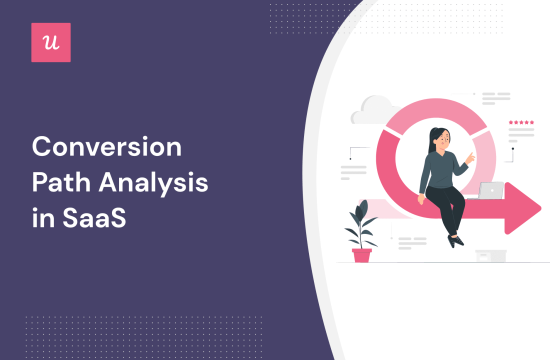Any savvy product manager should be able to create effective conversion paths – but that doesn’t happen by accident. It starts with conversion path analysis.
In this article, we’ll explain what a good conversion path is, what the underlying analytics of an effective conversion path look like, describe some common conversion paths, and ultimately why they matter.
Let’s get to it!
TL;DR
- A conversion path is a guided journey that a potential customer follows, all the way from a first time visitor to your website through to their final conversion to paying customers.
- Not all conversion paths are the same. There are three main types of conversion path to consider: the path to acquisition, to activation, and to growth.
- Why should you analyze conversion paths in the first place? Successful conversion paths will help you figure out the ‘happy path‘ so you can apply it to other users. You can use them to optimize customer acquisition. Finally, conversion path analysis can show you how to dramatically improve user onboarding.
- You can use an assisted conversions report in Google Analytics to figure out which of your conversion paths (i.e. different sequences of channel interactions) led to the most conversions in your app.
- Analyzing conversion paths based on activation and adoption requires a different tactic: here, you want to figure out which of your conversion paths lead to drop off points, and which perform the best (i.e. in driving assisted conversions) so you can optimize them.
- The final type of conversion path analysis is growth-based. Your best tool here is analyzing the end point of your most successful conversion paths (i.e. a user clicking on the “Upgrade” button in your product) and reverse engineering the process from there to generate more upgrades.
- Of course, you’ll need the right tool for the job to help you conduct this sort of analysis and optimize your own conversion paths. Userpilot will be launching a new, powerful ‘Paths’ feature next quarter, so watch out for that! Book a demo to learn more!
What is a conversion path?
A SaaS conversion path is the guided journey that a potential customer follows from an anonymous website visitor to potential customers, and eventually creates fully fledged, loyal subscribers to a product or service.
In a nutshell, a conversion path is a step-by-step process that turns qualified website visitors, first into leads, then into the final interaction before they become paying customers.
Important user conversion paths you should analyze across the customer journey
Different stages of the customer journey warrant different conversion paths. You have essentially three main starting points:
- Path to acquisition. This unique conversion path is primarily about acquiring and retaining new customers. One of the most popular referral paths here is transforming website visitors into free trial users.
- Path to activation and adoption. Next up, it’s about demonstrating value to your users and helping them reach the activation point (i.e. therefore bumping up conversion rates for trial users to paying active users). There are many important conversion events you need to fold in at this stage.
- Path to growth (upgrades). You need to effectively market new features, sell the customer experience, and upsell to your target audience.
Why is conversion path analysis important?
How do successful conversion paths help? Here are a few key reasons to bear in mind:
- Help to identify the happy path. By successfully understanding and mapping out how users achieve value in your product, you are well-positioned to optimize the experience and drastically reduce the time lag to value.
- Optimize acquisition. Use default channel grouping to figure out the most effective ways to acquire new users.
- Improve your onboarding. Conversion path analysis can show you how to tweak your onboarding flows so free trial users get off to a fast start (i.e. monitoring which desired action has the best response).
How to analyze conversions path to acquisition
You know what a conversion path is, and how identifying them can help. Now, we’ll break down how you can use them to boost acquisition.
Identify top conversion paths with Google Analytics
Google Analytics is a powerful, universal analytics tool that makes it simple to identify your top conversion paths.
The ‘Top Conversion Paths’ report shows all of the unique conversion paths (i.e. different sequences of channel interactions) that led to conversions in your app, alongside the number of conversions from each path, and the value of those conversions.
Each path populates the channels through which a user arrived during prior to each completed conversion.
Taken as a whole, those pieces of information can help you build a picture of how customers interact with each of your conversion paths.

Determine conversion path length with Time Lag report in Google Analytics
The Time Lag report shows how many conversions resulted from conversion paths organized by date range (from 0 to 12+ days). This sort of data can give you a huge amount of insight into the overall length of your online sales cycle and if there are any important trends in conversions.

Use conversion path length report to monitor how many clicks users take to complete conversions
The Path Length report takes a different approach. Rather than displaying data across time, this report looks at the overall volume of channel interactions. A path length report sets out how many conversions resulted from conversion paths containing a given number of channel interactions.

How to analyze conversion paths to activation and adoption
Next up, we’ll look at a different category of conversion path: those that help you focus on how you take users from signup to paid conversion. On the whole, these paths should help drive increased usage and adoption of the features that drive customer value.
Nail these, and you’ll easily maximize the number of conversions in the activation and adoption stages.
Generate a conversion path report using a tool
You could build a customer report to identify where customers are converting. That will typically involve:
- Setting out where your conversion path starts, finishes, and corresponding events in the path.
- Defining a clear conversion criteria.
- Identifying how many specific conversion paths result in retention.
- Nailing down the paths users take after sign in (i.e. specifying their entry point).
- Working to clarify which points in the journey drive value.

Identify which path leads to drop-offs in the customer journey
Just as important as identifying the most valuable points is figuring out which path is causing users to ‘drop off’ or ‘drop out’ of the customer journey. These typically correlate with friction points, pain points, and help you identify where your greatest opportunities for improvement can be found.

Determine top conversion paths and optimize them
Rather than spreading your efforts too thin, you need to prioritize your efforts.
You can improve your chance of converting the most users by choosing the most successful conversion path and exploring how you can optimizing them (i.e. making them more mobile-friendly, tweaking copy to improve journey completion and generate more leads).

How to analyze conversion paths to growth
We’ve covered conversion paths for acquisition, activation and adoption. But what about continuous improvement, growth, and evolving the product?
Let’s look at how conversion paths can be used to drive growth.
Identify which conversion path leads to upgrades
“Begin with the end in mind.”
Start by looking at the end of a successful conversion path (i.e. a user clicking on the “Upgrade” button in your product). You know that’s where you want to end up. Then it’s a case of looking into your conversion paths report and working backwards from that end state to identify the 10 steps prior.
For example, step one might be looking at how a user navigates from a landing page, interacts with key features, engages with dynamic elements, and more.
Conclusion
We’ve covered a lot of ground.
Hopefully, you now have a far better grasp of exactly what a conversion path is, how different reports and attribution models distribute credit to different elements in an onboarding path, and how you can utilize them to meet a range of strategic goals in your SaaS.
CTA: Want to get started with analyzing and improving conversion paths in your SaaS? Get a Userpilot Demo and see how you can get started today.




![how-to-conduct-effective-customer-interviews-[video]](https://prodsens.live/wp-content/uploads/2024/08/26660-how-to-conduct-effective-customer-interviews-video-380x250.png)
